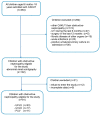The Usefulness of Urinary Periostin, Cytokeratin-18, and Endoglin for Diagnosing Renal Fibrosis in Children with Congenital Obstructive Nephropathy
- PMID: 34768419
- PMCID: PMC8585114
- DOI: 10.3390/jcm10214899
The Usefulness of Urinary Periostin, Cytokeratin-18, and Endoglin for Diagnosing Renal Fibrosis in Children with Congenital Obstructive Nephropathy
Abstract
Congenital obstructive nephropathy (CON) leads to renal fibrosis and chronic kidney disease. The aim of the study was to investigate the predictive value of urinary endoglin, periostin, cytokeratin-18, and transforming growth factor-β1 (TGF-β1) for assessing the severity of renal fibrosis in 81 children with CON and 60 controls. Children were divided into three subgroups: severe, moderate scars, and borderline lesions based on 99mTc-ethylenedicysteine scintigraphy results. Periostin, periostin/Cr, and cytokeratin-18 levels were significantly higher in the study group compared to the controls. Children with severe scars had significantly higher urinary periostin/Cr levels than those with borderline lesions. In multivariate analysis, only periostin and cytokeratin-18 were independently related to the presence of severe and moderate scars, and periostin was independently related to borderline lesions. However, periostin did not differentiate advanced scars from borderline lesions. In ROC analysis, periostin and periostin/Cr demonstrated better diagnostic profiles for detection of advanced scars than TGF-β1 and cytokeratin-18 (AUC 0.849; 0.810 vs. 0.630; 0.611, respectively) and periostin for detecting borderline lesions than endoglin and periostin/Cr (AUC 0.777 vs. 0.661; 0.658, respectively). In conclusion, periostin seems to be a promising, non-invasive marker for assessing renal fibrosis in children with CON. CK-18 and TGF-β1 demonstrated low utility, and endoglin was not useful for diagnosing advanced scars.
Keywords: children; congenital obstructive nephropathy; cytokeratin-18; endoglin; periostin; renal fibrosis; transforming growth factor-β1.
Conflict of interest statement
The authors declare no conflict of interest.
Figures
Similar articles
-
Serum and urine periostin and cytokeratin-18 in children with congenital obstructive nephropathy.Cent Eur J Immunol. 2022;47(1):63-72. doi: 10.5114/ceji.2022.115687. Epub 2022 May 10. Cent Eur J Immunol. 2022. PMID: 35600153 Free PMC article.
-
Transforming Growth Factor-Beta 1 and Endoglin Levels in Congenital Solitary Functioning Kidney.Indian J Nephrol. 2020 Jul-Aug;30(4):270-276. doi: 10.4103/ijn.IJN_111_19. Epub 2020 Feb 11. Indian J Nephrol. 2020. PMID: 33273793 Free PMC article.
-
Temporal changes in renal endoglin and TGF-beta1 expression following ureteral obstruction in rats.J Physiol Biochem. 2005 Sep;61(3):457-67. doi: 10.1007/BF03168452. J Physiol Biochem. 2005. PMID: 16440600
-
The Role of Endoglin in Myocardial Fibrosis.Acta Cardiol Sin. 2017 Sep;33(5):461-467. doi: 10.6515/acs20170221b. Acta Cardiol Sin. 2017. PMID: 28959097 Free PMC article. Review.
-
The role of periostin in kidney diseases.Cent Eur J Immunol. 2021;46(4):494-501. doi: 10.5114/ceji.2021.110317. Epub 2021 Nov 1. Cent Eur J Immunol. 2021. PMID: 35125949 Free PMC article. Review.
Cited by
-
The effect of semen cuscutae flavonoid on Sertoli cells and blood-testis barrier in male infertility: integrating network pharmacology and experimental verification.Pharm Biol. 2023 Dec;61(1):986-999. doi: 10.1080/13880209.2023.2229380. Pharm Biol. 2023. PMID: 37386769 Free PMC article.
-
Periostin as a blood biomarker of muscle cell fibrosis, cardiomyopathy and disease severity in myotonic dystrophy type 1.J Neurol. 2023 Jun;270(6):3138-3158. doi: 10.1007/s00415-023-11633-1. Epub 2023 Mar 9. J Neurol. 2023. PMID: 36892629
-
Serum and urine periostin and cytokeratin-18 in children with congenital obstructive nephropathy.Cent Eur J Immunol. 2022;47(1):63-72. doi: 10.5114/ceji.2022.115687. Epub 2022 May 10. Cent Eur J Immunol. 2022. PMID: 35600153 Free PMC article.
-
The Usefulness of Vanin-1 and Periostin as Markers of an Active Autoimmune Process or Renal Fibrosis in Children with IgA Nephropathy and IgA Vasculitis with Nephritis-A Pilot Study.J Clin Med. 2022 Feb 25;11(5):1265. doi: 10.3390/jcm11051265. J Clin Med. 2022. PMID: 35268356 Free PMC article.
-
Protein Biomarkers in Chronic Kidney Disease in Children-What Do We Know So Far?J Clin Med. 2023 Jun 8;12(12):3934. doi: 10.3390/jcm12123934. J Clin Med. 2023. PMID: 37373629 Free PMC article. Review.
References
LinkOut - more resources
Full Text Sources
Research Materials


